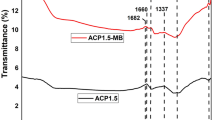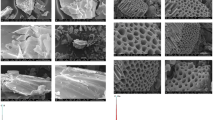Abstract
In this paper, activated carbon was synthesized by chemical activation using sodium hydroxide as an activating agent from residues of the stem and sheath palm fibres, and their efficacies in the removal of methylene blue were evaluated. The materials were characterized by techniques like thermogravimetric analysis (TGA), Fourier transform infrared spectroscopy (FTIR), X-ray diffraction (XRD), scanning electron microscopy (SEM), and surface area (BET). The influence of two experimental factors, such as contact time (10 to 70 min) and initial dye concentration (25, 50, 100, 250, and 500 mg.L− 1) was investigated. The adsorption process was followed by the Langmuir isotherm model with a maximum adsorption capacity of 110.79 and 162.54 mg.g− 1for stem and sheath palm. Results demonstrated that activated carbon from palm fibres have characteristics necessary for the removal of methylene blue. The equilibrium data were well adjusted in the Langmuir isotherm model, which confirms that the adsorption was heterogeneous and occurred through physicochemical interactions.
Graphic Abstract










Similar content being viewed by others
References
Somsesta N, Sricharoenchaikul V, Aht-Ong D (2020) Adsorption removal of methylene blue onto activated carbon/cellulose biocomposite films: Equilibrium and kinetic studies. Mater Chem Phys 240:122221. https://doi.org/10.1016/j.matchemphys.2019.122221
Wang G, Chen Y, Xu G et al (2019) Effective removing of methylene blue from aqueous solution by tannins immobilized on cellulose microfibers. Int J Biol Macromol 129:198–206. https://doi.org/10.1016/j.ijbiomac.2019.02.039
Conselho Nacional do Meio Ambiente. Resolução n.º 430, de 13 de maio de 2011. http://www.mma.gov.br/port/conama/legiabre., 2011 (accessed: 28 October 2019)
Conselho Nacional do Meio Ambiente, Resolução n.º 357, de 17 de março de 2005. http://www.mma.gov.br/port//conama/res/res05/res35705.pdf, 2005 (accessed 28 october 2019)
Youcef LD, Belaroui LS, López-Galindo A (2019) Adsorption of a cationic methylene blue dye on an Algerian palygorskite. Appl Clay Sci 179:105145. https://doi.org/10.1016/j.clay.2019.105145
Alfredo APC, Gonçalves GC, Lobo VS, Montanherb SF (2015) Adsorção de azul de metileno em casca de batata utilizando sistemas em batelada e coluna de leito fixo. RVQ 7:1909–1920. https://doi.org/10.5935/1984-6835.20150112
Liu S, Chen X, Ai W, Wei C (2019) A new method to prepare mesoporous silica from coal gasification fine slag and its application in methylene blue adsorption. J Clean Prod 212:1062–1071. https://doi.org/10.1016/j.jclepro.2018.12.060
Rezakazemia M, Shirazian S (2019) Lignin-chitosan blend for methylene blue removal: Adsorption modeling. J Mol Liq 274:778–791. https://doi.org/10.1016/j.molliq.2018.11.043
El Hajam M, Kandri NI, Harrach A et al (2019) Adsorption of Methylene Blue on industrial softwood waste “Cedar” and hardwood waste “Mahogany” comparative study. Mater Today Proceedings 13:812–821. https://doi.org/10.1016/j.matpr.2019.04.044
Heidarnejad Z, Rahmanian O, Fazlzadeh M, Heidari M (2018) Enhancement of methylene blue adsorption onto activated carbon prepared from Date Press Cake by low frequency ultrasound. J Mol Liq 264:591–599. https://doi.org/10.1016/j.molliq.2018.05.100
Li Z, Jia Z, Ni T, Li S (2017) Adsorption of methylene blue on natural cotton based flexible carbon fiber aerogels activated by novel air-limited carbonization method. J Mol Liq 242:747–756. https://doi.org/10.1016/j.molliq.2017.07.062
Pathania D, Sharma S, Singh P (2017) Removal of methylene blue by adsorption onto activated carbon developed from Ficus carica bast. Arab J Chem 10:1445–1451. https://doi.org/10.1016/j.arabjc.2013.04.021
Foo KY (2018) Effect of microwave regeneration on the textural network, surface chemistry and adsorptive property of the agricultural waste based activated carbons. Proc. Saf. Environ. Protec. 116:461–467. https://doi.org/10.1016/j.psep.2018.01.022
Chiang C-H, Chen J, Lin J-H (2020) Preparation of pore-size tunable activated carbon derived from waste coffee grounds for high adsorption capacities of organic dyes. J Environ Chem Eng 8:103929. https://doi.org/10.1016/j.jece.2020.103929
Beltrame KK, Cazetta AL, Souza PSC et al (2018) Adsorption of caffeine on mesoporous activated carbon fifibers prepared from pineapple plant leaves. Ecotoxicol Environ Saf 147:64–71. https://doi.org/10.1016/j.ecoenv.2017.08.034
Sarabandi D, Roudini G, Barahuie F (2019) Activated carbon derived from pine cone as a framework for the preparation of n-heptadecane nanocomposite for thermal energy storage. J Energy Storage 24:100795. https://doi.org/10.1016/j.est.2019.100795
El-Shafey EI, Ali SNF, Al-Busafifi S, AL-Lawatih AJ (2016) Preparation and characterization of surface functionalized activated carbons from date palm leaflflets and application for methylene blue removal. J Environ Chem Eng 4:2713–2724. https://doi.org/10.1016/j.jece.2016.05.015
Menya E, Olupot WP, Storz H (2018) Production and performance of activated carbon from rice husks for removal of natural organic matter from water A review. Chem Eng Res Des 129:271–296. https://doi.org/10.1016/j.cherd.2017.11.008
Enniya I, Rghioui L, Jourania A (2018) Adsorption of hexavalent chromium in aqueous solution on activated carbon prepared from apple peels. Sustain Chem Pharm 7:9–16. https://doi.org/10.1016/j.scp.2017.11.003
Sebron M, Gomez S et al (2020) Activated carbon from spent coffffee grounds as an adsorbent for treatment of water contaminated by aniline yellow dye. Ind Crops Prod 145:111953. https://doi.org/10.1016/j.indcrop.2019.111953
Sahu S, Pahi S, Sahu JK et al (2020) Kendu (Diospyros melanoxylon Roxb) fruit peel activated carbon—an efficient bioadsorbent for methylene blue dye: equilibrium, kinetic, and thermodynamic study. Environ Sci Pollut Res 27:22579–22592. https://doi.org/10.1007/s11356-020-08561-2
Yazdani MR, Duimovich N, Tiraferri A et al (2019) Tailored mesoporous biochar sorbents from pinecone biomass for the adsorption of natural organic matter from lake water. J Mol Liq 291:111248. https://doi.org/10.1016/j.molliq.2019.111248
Meili L, Lins PVS, Costa MT et al (2019) Adsorption of methylene blue on agroindustrial wastes: Experimental investigation and phenomenological modelling. Prog Biophys Mol Biol 141:60–71. https://doi.org/10.1016/j.pbiomolbio.2018.07.011
Han Q, Wang J, Goodman BA et al (2020) High adsorption of methylene blue by activated carbon prepared from phosphoric acid treated eucalyptus residue. Powder Technol 366:239–248. https://doi.org/10.1016/j.powtec.2020.02.013
Mulinari DR, Araujo MJF, Lopes GS (2015) Mechanical Properties of the Palm Fibers Reinforced HDPE Composites. World Acad Sci Eng Technol 2:824. https://doi.org/10.5281/zenodo.1109177
Mulinari DR, Guedes JR, Simba BG (2017) Low density polyethylene composites reinforced with Australian King Palm fibers: mechanical and thermal properties. Polym Bull 1:1–11. https://doi.org/10.1007/s00289-017-1963-9
Araujo MJF, Araujo MVF, Mulinari DR (2016) Evaluation of Biodegradability of a Compost Obtained from Polymeric Composite Reinforced Natural Fibers. Mater Sci Forum 869:265–269. https://doi.org/10.4028/www.scientific.net/MSF.869.265
Instituto Brasileiro de Geografia e Estatítica (2019) Produção Agrícola Municipal 2018. https://cidades.ibge.gov.br/brasil/pesquisa/15/0, (accessed: 14 June 2020).
Liu J, Yang X, Liu H et al (2020) Modification of calcium-rich biochar by loading Si/Mn binary oxide after NaOH activation and its adsorption mechanisms for removal of Cu(II) from aqueous solution. Colloids Surf A Physicochem Eng Asp 601:124960. https://doi.org/10.1016/j.colsurfa.2020.124960
Parre A, Karthikeyan B, Balaji A, Udhayasankar R (2020) Investigation of chemical, thermal and morphological properties of untreated and NaOH treated banana fiber. Mate Today Proceedings 22:347–352. https://doi.org/10.1016/j.matpr.2019.06.655
Takeuchi K, Fujishige M, Ishida N et al (2018) High porous bio-nanocarbons prepared by carbonization and NaOH activation of polysaccharides for electrode material of EDLC. J Phys Chem Solids 118:137–143. https://doi.org/10.1016/j.jpcs.2018.02.050
Chiang C-H, Chenb J, Lin J-H (2020) Preparation of pore-size tunable activated carbon derived from waste coffee grounds for high adsorption capacities of organic dyes. J Environ Chem Eng 8:103929. https://doi.org/10.1016/j.jece.2020.103929
Fallon PE, Rodriguez J, Wang JB (2017) QSWalk: A Mathematica package for quantum stochastic walks on arbitrary graphs. Comput Phys Commun 217:162–170. https://doi.org/10.17632/8rwd3j9zhk.1
Wolfram M (2020) https://www.wolfram.com/mathematica/, 2020 (accessed: 24 July 2020)
Erdogan SY, Önal Y, Akmil-Başar C et al (2005) Optimization of nickel adsorption from aqueous solution by using activated carbon prepared from waste apricot by chemical activation. Appl Surf Sci 252:1324–1331. https://doi.org/10.1016/j.apsusc.2005.02.089
Sousa TA, Habibe AF, Mulinari DR (2012) Caracterização das fibras da palmeira e do resíduo de fundição para produção de briquetes. Edição Especial do Curso de Mestrado Profissional em Materiais - junho/2012
Castro JP, Nobre JRC, Napoli A et al (2020) Pretreatment Affects Activated Carbon from Piassava. Polymers 12:1483. https://doi.org/10.3390/polym12071483
Das D, Samal DP, Meikap BC (2015) Preparation of Activated Carbon from Green Coconut Shell and its Characterization. J Chem Eng Process Technol 6:248. https://doi.org/10.4172/2157-7048.1000248
Rovira M, Giménez J, Martínez M et al (2008) Sorption of selenium (IV) and selenium (VI) onto natural iron oxides: goethite and hematite. J Hazard Mater 150:279–284. https://doi.org/10.1016/j.jhazmat.2007.04.098
Wei QF, Mather RR, Fotheringham AF, Yang RD (2003) Evaluation of nonwoven polypropylene oil sorbents in marine oil-spill recovery. Mar Pollut Bull 46:780–783. https://doi.org/10.1016/S0025-326X(03)00042-0
Alvarez JO, Saputra IWR, Schechter DS (2018) The Impact of Surfactant Imbibition and Adsorption for Improving Oil Recovery in the Wolfcamp and Eagle Ford Reservoirs. SPE J 23:2103–2117. https://doi.org/10.2118/187176-PA
Shen Y, Ge H, Meng M et al (2017) Effect of Water Imbibition on Shale Permeability and Its Influence on Gas Production. Energ Fuel 31:4973–4498. https://doi.org/10.1021/acs.energyfuels.7b00338
Hirata M, Kawasaki N, Nakamura T et al (2002) Adsorption of dyes onto carbonaceous materials produced from coffee grounds by microwave treatment. J Colloid Interface Sci 254:17–22. https://doi.org/10.1006/jcis.2002.8570
El-Shafey EI, Ali SNF, Al-Busafifi S, AL-Lawatih AJ (2016) Preparation and characterization of surface functionalized activated carbons from date palm leaflflets and application for methylene blue removal. J Environ Chem Eng 4:2713–2724. https://doi.org/10.1016/j.jece.2016.05.015
Liang S, Guo X, Feng N, Tian Q (2010) Isotherms, kinetics and thermodynamic studies of adsorption of Cu2 + from aqueous solutions by Mg2+/K + type orange peel adsorbent. J Hazard Mater 174:756–762. https://doi.org/10.1016/j.jhazmat.2009.09.116
Mulinari DR, Voorwald HJC, Cioffi MOH, Silva MLCP (2016) Cellulose fiber-reinforced high-density polyethylene composites–Mechanical and thermal properties. J Compos Mater 1:1–9. https://doi.org/10.1177/0021998316665241
Krishnamoorthy R, Govindan B, Banat F et al (2019) Date pits activated carbon for divalent lead ions removal. J Biosci Bioeng 128:88–97. https://doi.org/10.1016/j.jbiosc.2018.12.011
Ibupoto AS, Qureshi UA, Ahmed F et al (2018) Reusable carbon nanofifibers for efficient removal of methylene blue from aqueous solution. Chem Eng Res Des 136:744–752. https://doi.org/10.1016/j.cherd.2018.06.035
Doke KM, Khan EM (2017) Equilibrium, kinetic and diffusion mechanism of Cr(VI) adsorption onto activated carbon derived from wood apple shell. Arab J Chem 10:252–260. https://doi.org/10.1016/j.arabjc.2012.07.031
Mullick A, Neogi S (2016) Synthesis of potential biosorbent from used stevia leaves and its application for malachite green removal from aqueous solution: kinetics, isotherm and regeneration studies. RSC Adv 6:65960–65975. doi:https://doi.org/10.1039/C6RA15225B
Kaewsarn P, Saikaew W, Wongcharee S (2008) Dried Biosorbent Derived from Banana Peel: A Potential Biosorbent for Removal of Cadmium Ions from Aqueous Solution. The 18th Thailand Chemical Engineering and Applied Chemistry Conference October 20–21, 2008. https://www.researchgate.net/publication/317614977
Kumar A, Jena HM (2016) Removal of methylene blue and phenol onto prepared activated carbon from Fox nutshell by chemical activation in batch and fixed-bed column. J Clean Prod 137:1246–1259. https://doi.org/10.1016/j.jclepro.2016.07.177
Efimov MN, Vasilev AA, Muratov DG et al (2019) IR radiation assisted preparation of KOH-activated polymer-derived carbon for methylene blue adsorption. J Environ Chem Eng 7:103514. https://doi.org/10.1016/j.jece.2019.103514
El-Latif MMA, Ibrahim AM (2009) Adsorption, kinetic and equilibrium studies on removal of basic dye from aqueous solutions using hydrolyzed oak sawdust. Desalin Water Treat 6:252–268. https://doi.org/10.5004/dwt.2009.501
Nemr AE, Abdel WO, Amany ES, Khaled A (2009) Removal of direct blue-86 from aqueous solution by new activated carbon developed from orange peel. J Hazard Mater 161:102–110. https://doi.org/10.1016/j.jhazmat.2008.03.060
Li H, Liu L, Cui J et al (2020) High-efficiency adsorption and regeneration of methylene blue and aniline onto activated carbon from waste edible fungus residue and its possible mechanism. RSC Adv 10:14262. https://doi.org/10.1039/d0ra01245a
Saheed IO, Adekola FA, Olatunji GA (2017) Sorption Study of Methylene Blue on Activated Carbon Prepared from Jatropha curcas and Terminalia catappa Seed Coats. JOTCSA 4:375–394. https://doi.org/10.18596/jotcsa.287337
Gamal ME, Mous AH, El-Naas MH et al (2018) Bio-regeneration of activated carbon: A comprehensive review. Sep Purif Technol 197:345–359. https://doi.org/10.1016/j.seppur.2018.01.015
Carvalho DS, Cionek CA, Barros MASD, Arroyo PA (2015) Estudo da adsorção e dessorção do corante azul reativo BF5G em carvão ativado de osso. Blucher Chemical Engineering Proceedings https://doi.org/10.5151/chemeng-cobeq2014-0337-25946-164750
Acknowledgements
Authors are grateful for the research support by FAPERJ (process E-26 /010.001800 / 2015 and E-26 / 010.101232 / 2018).
Author information
Authors and Affiliations
Corresponding author
Ethics declarations
Conflict of interest
The authors declare that they have no conflict of interest.
Additional information
Publisher's Note
Springer Nature remains neutral with regard to jurisdictional claims in published maps and institutional affiliations.
Rights and permissions
About this article
Cite this article
Maia, L.S., da Silva, A.I.C., Carneiro, E.S. et al. Activated Carbon From Palm Fibres Used as an Adsorbent for Methylene Blue Removal. J Polym Environ 29, 1162–1175 (2021). https://doi.org/10.1007/s10924-020-01951-0
Accepted:
Published:
Issue Date:
DOI: https://doi.org/10.1007/s10924-020-01951-0




